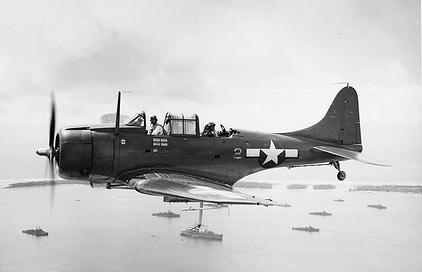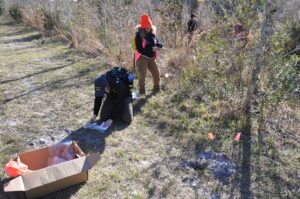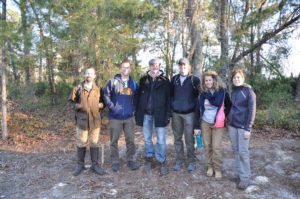A typical early spring for lighthouse archaeologists usually consists of days at the office researching, writing reports for previous field work, giving museum tours and starting the preparations for the upcoming field season. However, this past February two Lighthouse Archaeological Maritime Program (LAMP) archaeologists got the chance to get out of the office and participate in a terrestrial survey in Central Florida. The project, headed by archaeologist Dr. George Schwarz of the Naval History and Heritage Command (NHHC) in Washington, D.C., centered on the fragmented remains of a Navy aircraft, identified as a WWII era Scout Bomber Dauntless-5 (SBD-5) dive bomber, scattered over a large area near Osteen, Florida.
The carrier based SBD-5 is best known for its role in the Pacific during WWII, where they famously sunk four Japanese carriers in the pivotal battle of Midway. Florida’s own connection with the SBD-5 comes in the form of the Deland Naval Air Station, which acted as a major training base for Navy pilots of both land and carrier based aircraft between 1942 and 1946. It was from this station that the aircraft in question here, made its last ascent.

A WWII era photograph of an SBD-5 in flight.
(From http://www.delandnavalairmuseum.org/history.html)
Over 70 years after its final flight, this piece of war history began to tell its story when Osteen resident Rodney Thomas contacted the Deland Naval Air Station Museum, hoping to learn more about the apparent aircraft parts he was finding on his property. After working with the Central Florida Metal Detecting Club to collect a significant amount of artifacts, the museum contacted the NHHC, who in turn organized an archaeological survey of the area.
The project began on February 18, when we joined a diverse group of volunteers including fellow archaeologists from the Florida Public Archaeology Network and the University of West Florida, as well as members of the Central Florida Metal Detecting Club and museum volunteers at the Deland Naval Air Station Museum.

LAMP archaeologist Olivia McDaniel (me) and UWF graduate student Nikki Mauro record one of the many artifacts. Metal detectorists moved through the survey area marking artifacts with orange pin flags, visible in the lower left corner. Archaeologists followed behind to record, photograph, and collect each piece. Photograph courtesy of NHHC.
Project goals included locating and recovering remaining pieces of the aircraft in hope of finding diagnostic parts that would allow archaeologists to identify the specific aircraft and pilot involved.
Archaeologists would also record the GPS coordinates of each individual piece in order to create a site map showing the scatter of artifacts, which could potentially give archaeologists a clearer picture of the manner in which the aircraft crashed. A K-9 Search and Rescue team was also on hand to search the area for any human remains, and while the dogs identified an area of interest, a more thorough investigation of the location revealed no remains.
Over the course of the three day project, approximately 250 artifacts were collected through the collaborative efforts of the organizations involved. Some fragments were approximately the size of a dime, while the largest identifiable artifact was a crumpled section of exhaust pipe. Photographs of the artifacts were taken back to Washington, D.C., where NHHC archaeologists will continue their research in hopes of identifying the plane and its pilot. The majority of the recovered artifacts themselves remain, along with those previously collected, on display at the Deland Naval Air Station Museum.

Archaeologists from several institutions volunteered to help with this NHHC project. From left to right: LAMP volunteer archaeologist Brian McNamara, FPAN archaeologist Ryan Harke, project coordinator and NHHC archaeologist Dr. George Schwarz, LAMP archaeologist Olivia McDaniel, and UWF graduate students Nikki Mauro and Maddie Voas.
Photograph courtesy of NHHC.
Despite the short time frame of the project, it was overall very successful. A significant amount of data was recorded, it was a great learning experience, and it’s always a pleasure working with fellow archaeologists across the field. Thanks again to Dr. Schwarz and the NHHC for the invitation to help out with this bit of aviation archaeology!
For now, we here at LAMP are back in the office making preparations for the coming months. Be sure to check back in this May as we gear up for our summer field season!
Archaeologist Olivia McDaniel first joined the St. Augustine Lighthouse & Museum team in 2012 as a student at LAMP’s Underwater Archaeology Field School. She officially joined the lighthouse family as an archaeologist in July, 2014, after completing her bachelor’s degree at the University of Idaho.

